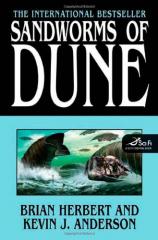Sandworms of Dune
Review
Sandworms of Dune
I
must confess to having been an absolutely voracious Dune
series fanatic back in the mid-1960s when the legendary Frank
Herbert began producing his amazing epic stories. His narrative
writing was as concentrated and potent as I’d always imagined
the fabled spice or melange to be, and certainly as addictive! When
Herbert died (too soon) in 1986, it seemed that the Dune
stories --- really a single-extended odyssey unrolled year by year
--- would end with him.
Like other giants of science fiction and fantasy (Tolkien,
Heinlein, Asimov, Roddenberry, for example), it turns out that
Frank Herbert’s fertile imagination produced mountains of
notes, sketches, ideas, outlines and musings destined for future
novels. And this is the daunting legacy taken up by his gifted son
Brian Herbert and long-time collaborator Kevin J. Anderson. After
the years of hiatus following Herbert Sr.’s death, they
produced additional lore derived from the original Dune elements
that evolved among powerful religious and familial dynasties
(notably the Atreides clan) that ruled the fictitious desert
planet, Arrakis.
SANDWORMS OF DUNE is the second of an extended double-novel
conclusion to the series that was launched in 2006 with HUNTERS OF
DUNE. Over an intense and breathlessly varied 500 pages, Herbert
and Anderson simultaneously unravel and re-weave the fabric of
Frank Herbert’s immense plot structure in a very credible
effort to bring its many components into a more or less harmonious
state of closure.
As readers will find from the opening pages, the Herbert-Anderson
technique of encompassing huge expanses of time, place and change
results in a large story told through many small slices of plot
that jump acrobatically through myriad dimensions. As disorienting
as such vast leaps in sequence and character can seem, SANDWORMS OF
DUNE does in fact establish a hypnotic rhythm and pace quite early
in the tale.
The point of this (apparently) last Dune novel is to
reconnect many dispersed key characters through their artificially
gestated descendents, a race of space-bred clones called gholas who
carry the memories, but not the direct experiences, of their
illustrious precursors --- Paul Atreides, Jessica, Duke Letos,
Chani, Stilgar, Dr. Yueh, Baron Harkonnen and Duncan Idaho.
The gap between concrete human experience and implanted ghola
knowledge runs as a subtle and powerful undercurrent throughout
this story, whose quest or mission is to reveal the final
“Kwisatz Haderach,” the superhuman, part-divine leader
who can save humanity. The pointed irony is that such a leader does
emerge, only to realize that people have changed so profoundly over
the millennia that the entire race needs to undergo a complete
philosophical and spiritual overhaul.
The broad structure in which the action and reaction of SANDWORMS
OF DUNE takes place explodes from a decisive drawing of battle
lines between human and machine intelligences, who don’t
limit themselves to the possession or destruction of mere planets,
but of entire solar systems and galaxies. What drives the
machine-beings are chillingly familiar traits learned from humanity
(lust, greed, vengeance, curiosity); what drives the uprooted
space-wandering humans are hauntingly familiar aspirations of the
soul, bound by a kind of syncretised pan-theology that sanctifies
both war and wisdom.
Forming another key subplot that takes on growing importance, like
a slow crescendo throughout the book, are the sandworms themselves,
who have a special rapport with certain humans and that harbor an
unexpected antipathy to machine intelligences. For years, the
behemoth worms have been the aliens readers love to hate, but they
are portrayed in this final link of the story as both perplexing
and paradoxical creatures with as-yet-untold potential to reform
entire worlds.
While the Herberts, both father and son, have often been dismissed
as theatrically long-winded writers who tell their stories the way
Richard Wagner built his gigantic meandering operas, such criticism
is too generalized to be meaningful. People have joked about
Wagnerian opera for generations, but his Ring of the Niebelung is
considered a pillar of human artistic achievement. The Dune
series has done at least as much for large-scale science
fiction.
And, we can’t be so sure that the final curtain has yet come
down on this grandiose “space opera.”
Reviewed by Pauline Finch (paulinefinch@rogers.com) on January 23, 2011
Sandworms of Dune
- Publication Date: August 7, 2007
- Genres: Fiction, Science Fiction
- Hardcover: 496 pages
- Publisher: Tor Books
- ISBN-10: 076531293X
- ISBN-13: 9780765312938





